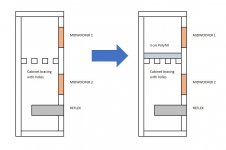Hello, what about the second configuration (covering the internal bracing holes with sheets of polyfill)?
In theory I'm going to form two aperiodic halved volume chambers (one approaching "sealed", and the other "reflex") separated by a sort of light Variovent (flow resistance but not too much damped, just few centimeters of not compressed polyfill)
Here I found few references with similar idea
I think I'm going to lower the Q of the cabinet and increasing the virtual Vb. Is this correct?
How to model the behaviour?
In theory I'm going to form two aperiodic halved volume chambers (one approaching "sealed", and the other "reflex") separated by a sort of light Variovent (flow resistance but not too much damped, just few centimeters of not compressed polyfill)
Here I found few references with similar idea
I think I'm going to lower the Q of the cabinet and increasing the virtual Vb. Is this correct?
How to model the behaviour?
Attachments
Last edited:
This was done on the Dynaudio Axis 5 kit by using three of their flow resistances per speaker. It was a closed box though.
Regards
Charles
Regards
Charles
I experimented with this in a speaker like yours, to reduce the standing wave effect on the upper woofer, and trying to improve subjective bass. The end solution was using as much stuffing as I could put in the bottom without disturbing the vent, and some loose stuffing in the middle. This was the best compromise for subjective bass, and the impedance bump from the standing wave was almost invisible.
Maybe I could have spent more time refining it and achieved some better results, but there was a lot of constraints with braces, port location etc in the box.
I think it would take a lot of tuning to align the aperiodic tuning and vent tuning. I also doubt there is much benefit, because pressure will be high on both sides of the aperiodic vent when the woofers are moving equally (some diff because of volume diff though), so there would probably not be very much 'venting' through it?
Maybe I could have spent more time refining it and achieved some better results, but there was a lot of constraints with braces, port location etc in the box.
I think it would take a lot of tuning to align the aperiodic tuning and vent tuning. I also doubt there is much benefit, because pressure will be high on both sides of the aperiodic vent when the woofers are moving equally (some diff because of volume diff though), so there would probably not be very much 'venting' through it?
Depends on exactly the damping used, but main value would be to help damp a longitudinal if you can locate it at the point of maximum particle velocity. You can roughly model it as a Fostex type DBR with short internal vent of the correct total CSA and length, and adjust its independent losses (Qp). As noted above, an easier if potentially less acoustically efficient way would be simply to increase the quantity of damping at the top / base of the enclosure to suppress the longitudinal eigenmode, or (possibly more efficiently, if the dimensions are practicable) design the box as an MLTL where you factor it into the alignment from the outset & it's either used or largely suppressed via optimised driver, vent positioning.
